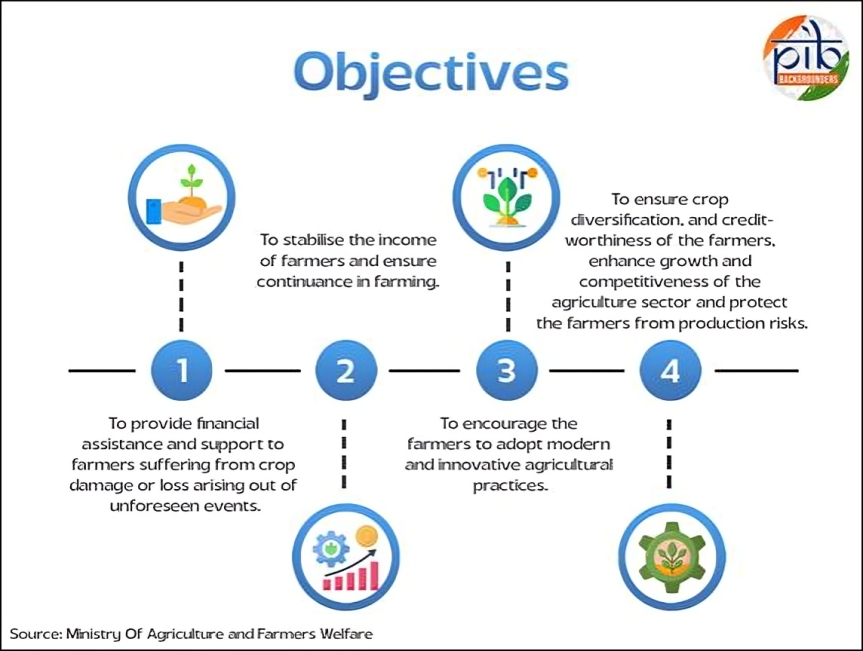Important Facts For Prelims
PMFBY Expansion to Cover Wildlife Damage and Paddy Inundation
- 21 Nov 2025
- 5 min read
Why in News?
The Ministry of Agriculture and Farmers Welfare has announced that the Pradhan Mantri Fasal Bima Yojana (PMFBY) will now cover crop losses due to wild animal attacks and paddy inundation from the Kharif season 2026.
- In 2018, paddy inundation (damage caused by floods and heavy rainfall) was removed from the localised calamity category due to assessment challenges, but it has now been re-included.
What is the Pradhan Mantri Fasal Bima Yojana (PMFBY)?
- About: PMFBY is a Central Sector Scheme launched in 2016 by the Ministry of Agriculture & Farmers Welfare.
- It provides financial protection to farmers against crop losses caused by natural disasters, pests, or diseases and aims to support farmers financially.
- Objectives:
- Eligibility & Coverage: All farmers, including sharecroppers and tenant farmers cultivating notified crops in designated areas, are eligible for coverage under PMFBY.
- Participation is voluntary, with non-loanee farmers making up 55% of the total beneficiaries.
- The number of farmer applications has risen from 371 lakh in 2014-15 to 1510 lakh in 2024-25, while non-loanee farmer applications grew from 20 lakh to 522 lakh over the same period.
- Risk Protection: PMFBY offers comprehensive protection against a range of risks.
- Natural Disasters: Covers losses from floods, droughts, cyclones, hailstorms, landslides, and unseasonal rainfall.
- Pest & Disease Protection: Safeguards crops against pest infestations and diseases.
- Post-Harvest Losses (Individual Farm Basis): Provides compensation for damages within 14 days of harvest, particularly for crops in a “cut and spread” condition.
- Localised Calamities: Offers individual farm-based compensation for localized disasters e.g., hailstorms, landslides etc.
- Prevented Sowing (Notified Area Basis): Farmers who cannot sow due to adverse weather despite intent and incurred costs can claim up to 25% of the sum insured.
- Premium Rates: Farmers contribute affordable premiums of 2% for Kharif crops, 1.5% for Rabi crops, and 5% for annual commercial or horticultural crops.
- The government provides full premium subsidies for farmers in the Northeast, Jammu & Kashmir, and Himachal Pradesh.
- Technology Deployment for Loss Assessment:
- Satellite Imagery & Drones: Employed to estimate crop areas, resolve yield disputes, and assess crop losses.
- Crop Cutting Experiments (CCEs): The CCE-Agri App allows direct data uploads to the National Crop Insurance Portal (NCIP), ensuring transparent yield evaluations.
- YES-TECH (Yield Estimation System Based on Technology): It enables remote sensing-based crop yield estimation for fair and accurate assessments.
- Additional Tools: The scheme also leverages DigiClaim, CROPIC (Collection of Real-Time Observations and Photographs of Crops), and WINDS (Weather Information Network Data Systems) for accurate and timely assessments.
- Quick Settlement: PMFBY guarantees claim settlement within two months of harvest, offering timely compensation to help farmers prevent falling into debt.
Frequently Asked Questions (FAQs)
1. What is PMFBY?
PMFBY is a central sector scheme providing financial protection to farmers against crop losses due to natural disasters, pests, and diseases.
2. Who is eligible for PMFBY coverage?
All farmers, including sharecroppers and tenant farmers cultivating notified crops in designated areas, with participation being voluntary.
3. What recent changes are being introduced in PMFBY from Kharif 2026?
Inclusion of wild animal attacks as localised risk and reintroduction of paddy inundation cover to enhance protection for farmers in vulnerable areas.
UPSC Civil Services Examination Previous Year Question (PYQ)
Q. With reference to ‘Pradhan Mantri Fasal Bima Yojana’, consider the following statements: (2016)
- Under this scheme, farmers will have to pay a uniform premium of two percent for any crop they cultivate in any season of the year.
- This scheme covers post-harvest losses arising out of cyclones and unseasonal rains.
Which of the statements given above is/are correct?
(a) 1 only
(b) 2 only
(c) Both 1 and 2
(d) Neither 1 nor 2
Ans: (b)







